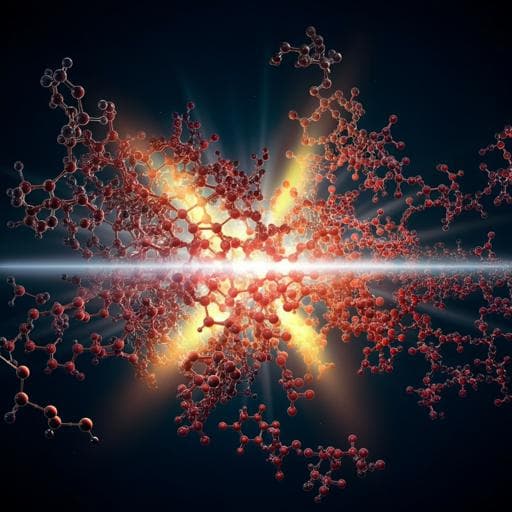
Engineering and Technology
19.31% binary organic solar cell and low non-radiative recombination enabled by non-monotonic intermediate state transition
J. Fu, P. W. K. Fong, et al.
Discover an innovative strategy to boost organic solar cell efficiency! This research, conducted by Jiehao Fu, Patrick W. K. Fong, Heng Liu, and their team, utilizes a novel non-monotonic intermediate state manipulation approach, achieving a record efficiency of 19.31%. Don't miss how this method reduces non-radiative recombination loss, paving the way for advanced solar technology.
~3 min • Beginner • English
Introduction
Organic solar cells (OSCs) using non-fullerene acceptors (NFAs) have surpassed 18% power conversion efficiency (PCE), yet still lag perovskites largely due to high non-radiative recombination losses. The challenge is to form high-quality bulk-heterojunction (BHJ) active layers that suppress non-radiative loss while preserving efficient charge generation and transport. Active-layer quality depends on donor–acceptor distribution and molecular stacking and is strongly influenced by drying/crystallization kinetics. Traditional morphology-control strategies (solvent/additive treatments such as DIO, solvent annealing) often increase NFA crystallinity but can drive excessive aggregation, elevating voltage loss due to non-radiative recombination. This work proposes a new morphology-regulating approach using 1,3,5-trichlorobenzene (TCB) as a crystallization regulator to manipulate intermediate states during film formation in a non-monotonic way—first enhancing, then relaxing molecular aggregation—to simultaneously optimize crystallization and reduce non-radiative recombination, targeting record efficiencies in binary OSCs.
Literature Review
Prior studies showed that slowing solvent evaporation or employing additives can increase polymer order and crystallinity in BHJs; solvent annealing and high-boiling additives are central to fullerene-based OSCs. In NFA-based systems, common additives like 1,8-diiodooctane (DIO) enhance acceptor crystallinity but affect donors less and, due to low volatility, often induce excessive NFA aggregation and higher non-radiative losses, leading to larger Voc losses than as-cast devices. Volatilizable solid additives improved stability but offered limited PCE gains over solvent additives. Recent eutectic-phase concepts demonstrated additive–acceptor interactions can drive nanomorphology optimization. However, detailed insights into drying/crystallization kinetics in NFA blends are limited by characterization constraints. These gaps motivate exploration of new regulators (e.g., TCB) capable of interacting with both donor and acceptor and leaving no residue to avoid traps and aggregation-induced losses.
Methodology
- Materials and device architecture: Binary BHJ OSCs based on systems including PM6:Y6, PM1:BTP-eC9, PM6:BTP-eC9, PBDB-T:ITIC, PBDB-T-2Cl:IT-4F, and BTR-Cl:Y6. Typical device structures: conventional ITO/PEDOT:PSS/active layer/PFN-Br or Phen-NaDPO/Ag and inverted ITO/ZnO/active layer/MoO3/Ag. Active layers spin-coated from chloroform (or chlorobenzene for some systems) with either DIO (benchmark) or TCB (crystallization regulator) additive; thickness ~110 nm; followed by brief thermal annealing.
- Additive strategy: Use 1,3,5-trichlorobenzene (TCB) as a crystallization regulator at mg mL−1 levels. Compared to DIO, TCB is highly volatile (77 Pa at 25 °C vs 0.03 Pa for DIO), enabling removal during spin-coating. Density functional theory indicates TCB forms hydrogen bonds with donor (PM6/PM1) and acceptor (Y6/BTP-eC9) via –CO…H and –CN…H interactions, transiently enhancing order in both components.
- Thermal/phase analysis: Differential scanning calorimetry (DSC) on neat materials and mixtures (PM6, Y6, blends with TCB) to reveal new exothermic peaks upon cooling in TCB-containing mixtures, indicative of new interaction phases/intermediate states; TGA for volatility characteristics.
- In situ film-formation probes: In situ time-resolved UV–vis reflectance (temporal resolution ~0.4 s) during spin-coating to monitor spectral evolution. DIO samples saturate rapidly (~0.73 s), whereas TCB samples evolve over >10 s and exhibit a non-monotonic transition: initial redshift (enhanced stacking) followed by blueshift (relaxation) until steady state, evidencing first-enhance-then-relax aggregation dynamics. In situ GIWAXS at ALS was attempted but lacked sufficient temporal sensitivity for the short-lived transition states.
- Morphology/crystallinity: AFM (tapping mode) for topography/roughness and aggregation features; GIWAXS (2D/1D) to assess lamellar and π–π stacking and crystalline orientation; quantify peak areas for crystallinity comparison.
- Charge transport and recombination: Space-charge limited current (SCLC) to extract electron and hole mobilities; transient photovoltage (TPV) decay to assess recombination lifetimes; Voc vs light intensity to infer recombination order/trap-assisted processes.
- Optoelectronic characterization: J–V under AM1.5G; EQE and integrated Jsc; highly sensitive electroluminescence quantum efficiency (EQEEL).
- Energy-loss analysis: Detailed balance framework partitioning total energy loss (Eloss) into ΔE1 (radiative above bandgap), ΔE2 (radiative below bandgap/CT states), and ΔE3 (non-radiative), computed from JV parameters and bandgap, and independently from EQEEL (ΔE3 = −kT ln(EQEEL)).
- Stability: Maximum power point (MPP) tracking under continuous 1-sun equivalent illumination to quantify PCE decay and T80 lifetimes, comparing DIO vs TCB processing.
Key Findings
- TCB induces a non-monotonic intermediate state during film formation: in situ UV–vis shows an initial redshift (enhanced stacking) then blueshift (relaxation) over ~10 s, unlike DIO which saturates rapidly (~0.73 s), leading to excessive aggregation.
- PM6:Y6 devices: TCB improves all metrics over DIO. Champion with TCB: Voc 0.852 V, Jsc 27.02 mA cm−2, FF 78.43%, PCE 18.06% (avg 17.86 ± 0.09%), vs DIO: Voc 0.829 V, Jsc 26.60 mA cm−2, FF 76.36%, PCE 16.83% (avg 16.61 ± 0.10%). Integrated Jsc agrees (TCB 26.31, DIO 26.06 mA cm−2).
- Energy losses (PM6:Y6): Similar ΔE1 (~0.26 eV) and ΔE2 (~0.06 eV). Non-radiative loss ΔE3 reduced with TCB: 0.214 eV (from JV) vs 0.233 eV with DIO; from EQEEL, TCB EQEEL = 3.4×10−2 (ΔE3 ≈ 0.206 eV) vs DIO EQEEL = 1.7×10−2 (ΔE3 ≈ 0.224 eV).
- Transport/recombination: TCB yields slightly higher hole mobility (3.0×10−4 vs 2.5×10−4 cm2 V−1 s−1) and similar electron mobility (~3.6×10−4 cm2 V−1 s−1); longer TPV decay (τ = 1.82 μs vs 1.39 μs); near-unity ideality factor (n ≈ 1.02 vs 1.09), indicating reduced trap-assisted recombination, consistent with higher volatility/no residue of TCB.
- Morphology/crystallinity: AFM shows fewer crater-like aggregates with TCB; GIWAXS indicates larger lamellar and π–π peak areas (higher crystallinity) and preferred face-on orientation. TCB increases crystallinity of both donor and acceptor, correlating with more balanced/faster transport.
- High-efficiency binary systems: Record PM6:BTP-eC9 PCE 19.31% with TCB-ISM (certified 18.93%); non-radiative loss ΔE3 ≈ 0.19 eV. PM1:BTP-eC9 reaches 19.10% with exceptionally low ΔE3 = 0.168 eV (from JV), among the lowest reported for efficient (PCE ≥ 16%) OSCs; EQEEL-based ΔE3 ≈ 0.175 eV with EQEEL up to 1.1×10−2.
- Generality across systems: TCB outperforms DIO in five additional systems (BTR-Cl:Y6; PBDB-T:ITIC; PBDB-T-2Cl:IT-4F; PM1:BTP-eC9; PM6:BTP-eC9), consistently boosting Voc, FF, and PCE.
- Stability: Under 1-sun MPP tracking (PM6:BTP-eC9), TCB-treated devices show reduced initial burn-in (−7% vs −17% in 75 h), T80 = 660 h (vs 169 h for DIO), and retain 78% PCE at 1000 h (vs 69% for DIO).
Discussion
The study addresses how to suppress non-radiative recombination in NFA-based OSCs without compromising charge generation and transport by tailoring BHJ crystallization/drying dynamics. Using TCB as a transient crystallization regulator yields a controlled, non-monotonic intermediate state: initial additive–active-material interactions strengthen molecular stacking in both donor and acceptor, followed by relaxation as volatile TCB evaporates, avoiding excessive acceptor aggregation. This produces more ordered yet suitably aggregated morphologies, enhancing carrier mobilities, balancing transport, and reducing traps. Consequently, ΔE3 (non-radiative loss) decreases while Voc, Jsc, and FF improve, culminating in record binary PCE and exceptionally low non-radiative loss. The mechanism is supported by DSC (new cooling-phase peaks with TCB), DFT (hydrogen-bond interactions), in situ UV–vis (two-step spectral evolution), AFM/GIWAXS (enhanced crystallinity and orientation), and recombination analyses (TPV, Voc–light intensity, EQEEL). The approach generalizes across multiple donor–acceptor systems and also enhances operational stability, likely via more uniform aggregation, higher crystallinity that slows light-induced morphology evolution, and absence of residual additive. Overall, ISM processing directly tackles the central bottleneck of non-radiative losses in high-efficiency OSCs.
Conclusion
A non-monotonic intermediate state manipulation (ISM) strategy employing 1,3,5-trichlorobenzene as a volatile crystallization regulator enables simultaneous optimization of BHJ morphology and energy-loss pathways. By transiently enhancing and then relaxing molecular aggregation during film formation, ISM suppresses non-radiative recombination while improving charge transport. This delivers record binary OSC performance (PM6:BTP-eC9 PCE 19.31%, 18.93% certified) and among the lowest reported non-radiative losses (PM1:BTP-eC9 ΔE3 = 0.168 eV), with improved operational stability. The strategy is versatile across diverse donor–acceptor systems. Future work could extend ISM to broader NFA/donor chemistries, optimize additive dosing and processing windows, integrate with scalable coating methods, and advance in situ structural probes with higher temporal resolution to further resolve transient states.
Limitations
- In situ GIWAXS at available temporal resolution (≥1 s exposure) could not resolve the short-lived transition states (~10 s) during spin-coating; mechanistic insights relied primarily on in situ UV–vis reflectance. Higher-speed structural probes would strengthen direct evidence of transient ordering.
- While demonstrated across several representative donor–acceptor systems, the approach was not exhaustively validated for all material classes or large-area, roll-to-roll processes within this study.
- Reported device metrics pertain to specific processing conditions (solvents, concentrations, annealing); broader processing windows and environmental variations were not fully mapped.
Related Publications
Explore these studies to deepen your understanding of the subject.







